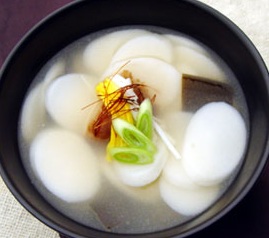Hey guys, so there are only two days until the 2012 Lunar New Year. I know that there are a lot of dishes that are prepared for this event, but there is one that everyone know about and is a definite must at this event. Rice Cake Soup or tteokguk 떡국.
This is something that can not be left out of the celebrations because it is believed to grant the consumer luck for the forthcoming year and gain an additional year of life. It is usually garnished with thin julienned cooked eggs, marinated meat, and gim (dried seaweed or laver)
The history of the dish is actually quite unknown. However, tteokguk is mentioned in the 19th century book of customs Dongguksesigi (동국세시기, 東國歲時記) as being made with beef or pheasant used as the main ingredient for the broth, and pepper added as seasoning. The book also mentions the custom of having a bowl of tteokguk in the morning of New Year's Day to get a year older, and the custom of saying "How many bowls of tteokguk have you eaten?" to ask a person's age.
In the book The Customs of Joseon written in 1946 by historian Choe Nam-seon, the New Year custom of eating tteokguk is speculated as being originated from ancient times. The white tteok signifying purity and cleanliness would be eaten as a ritual to start off the New Year for good fortune.
Although tteokguk is traditionally a seasonal dish, it is now eaten at all times of the year.
The broth is generally made by simmering the main protein (beef, chicken, pork, seafood) in a soy sauce-based seasoned stock. The stock is then strained to clarify the broth and long cylinder-shaped rice cakes (garaetteok) are thinly sliced diagonally and boiled in the broth. Garnish is added before serving and it may vary by region and personal taste.
Varieties of tteokguk include: saeng tteokguk (생떡국) or nal tteokguk (날떡국), a specialty of Chungcheong province, where a mixture of non-glutinous rice with glutinous rice is made into small balls or rolled into a garaetteok shape and then sliced into a boiling broth; joraengi tteokguk (조랭이 떡국) from the Kaesong region with the tteok twisted in small cocoon shapes; and gon tteokguk (곤떡국) from the island of Jeju, which uses sliced jeolpyeon tteok rather than the usual garaetteok.
Another variety, tteokmanduguk is literally tteokguk with additional mandu.
I think that is enough about the history of tteokguk and its other varieties. It is time to introduce you to the dish that you will be making is two days time.
Ingredients300g Diagonally sliced rice cake
100g Beef brisket
1 clove Garlic
2tbs Fish sauce
3 Eggs
1 sheet Laver (dried seaweed)
Green onion
Sesame oil
Black ground pepper
Method1. Boil 8 cups of water in a pot.
2. Soak sliced rice cake in cold water.
3. Chop beef brisket into small pieces.
4. Prepare 3 eggs in 2 small bowls:
5. In the first bowl, put 2 egg yolk;
6. In the second bowl, put 2 egg white and 1 egg;
8. Add a pinch of salt to each bowl and mix well.
Cooking the Egg9. Heat up a non-stick pan. Let it get really hot. Add a few drops of vegetable oil, and wipe off the excess hot oil with a paper towel.
10. Turn the heat off. Pour the egg yolk mixture from “bowl 1″ above into the pan and spread it thinly. You want to make a thin yellow paper out of the egg by tilting the pan.
11. When it’s almost cooked through, turn it over and let it sit on the pan to cook the other side.
12. Slice it thinly and set it aside.
Laver Powder13. Roast a sheet of laver (kim) directly on the stove top. Both sides of the laver should be roasted so that it can be crushed easily.
14. Put the roasted laver into a plastic bag and crush it! Then set it aside.
Finishing off the Soup15. When the water boils, put in the beef. Boil over low medium heat for 20-30 minutes.
16. Open the lid and add minced garlic and fish sauce.
*tip: the water will boil off but you want to keep it at 6 cups. You can add more water as you need it.17. Drain the rice cake slices and put them into boiling beef soup. Close the lid.
18. A few minutes later, open the lid to check if rice cake slices are floating on the surface. You can taste a sample now.
19. Pour in the egg mix from “bowl 2″ above, a little at a time.
*tip: Don’t stir it until the egg mixture is cooked a little in the broth20. Chop some green onion and add it to the pot.
21. Turn off the heat and drizzle some sesame oil and grind a little black pepper.
22. Transfer the rice cake soup to serving bowls. Garnish with the roasted laver powder and the thin egg yolk strips.
Serve hot.



And there you have it, a delicious dish to welcome the New Year and something that you can make on a cold and drizzly day.
That is it for my post today, but I wish you all a Happy Lunar New Year, and I pray that you will all be healthy and safe in 2012. May all your dreams come true and that you will all continue to support my blog as I will continue to come up with recipes.
Happy Lunar New Year!! 새해 복 많이 받으세요!! *BIG bow*


